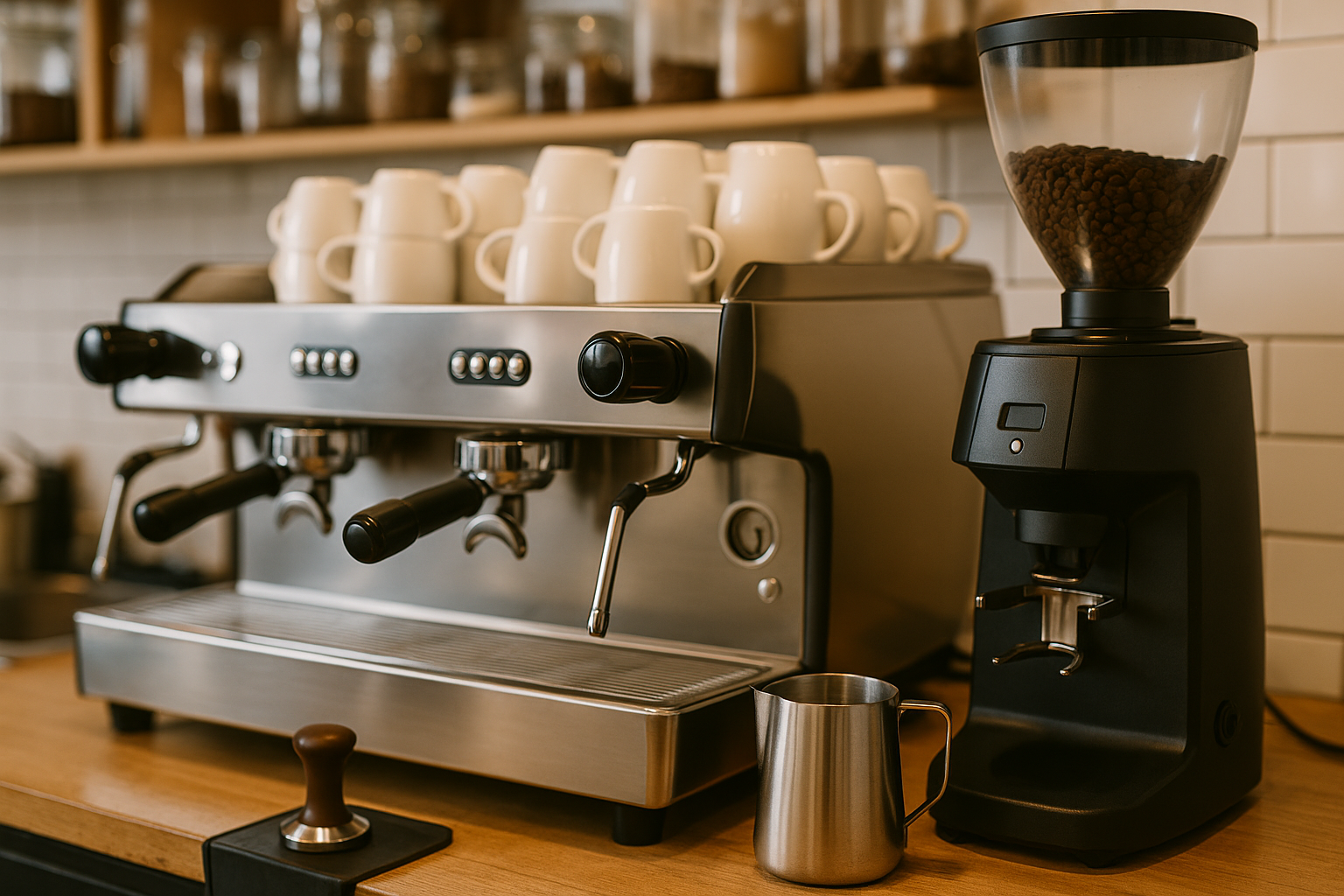Every barista knows that working in a coffee shop is about much more than just knowing how to make espresso.
You also need to understand the tools of your trade. From the moment you clock in to your final wipe-down at close, you’re surrounded by gear — each piece essential to keeping the café running smoothly.
Knowing your equipment doesn’t just make you faster. It makes you more confident, more respected by your team, and more valuable to your manager.
In this article, we’ll walk through the essential equipment you’ll use daily as a barista, and how mastering each one helps you become a stronger, more professional part of the café team.
1. Espresso Machine: Your Daily Companion
If you’re a barista, this is your main stage. Espresso machines vary in size, brand, and complexity, but their purpose is always the same: to extract rich, concentrated coffee under high pressure.
You’ll use it to:
- Pull espresso shots
- Steam and texture milk
- Create espresso-based drinks like lattes, cappuccinos, and macchiatos
Key parts to know:
- Group head – where the portafilter locks in
- Portafilter – the handle that holds your ground coffee
- Steam wand – used to steam and froth milk
- Hot water spout – often used for americanos or cleaning
- Boiler pressure gauge – helps ensure stable pressure and temperature
Pro tip:
Learn how to purge, backflush, and clean your machine properly. Daily care extends the life of the equipment and keeps your drinks tasting consistent.
2. Grinder: The Key to Consistency
Behind every great espresso shot is a dialed-in grind. The grinder is responsible for turning whole beans into perfectly sized particles that match your brew method and recipe.
Two main types:
- Espresso grinders – designed for fine, precise adjustments
- Batch brew grinders – used for larger quantities and coarser grind sizes
What you’ll do with it:
- Adjust grind size (fine or coarse) based on shot time or brew method
- Refill hopper and keep beans fresh
- Clean burrs regularly to avoid stale oils and residue
Why it matters:
A grinder out of calibration will ruin your espresso — no matter how skilled you are on the machine.
3. Scale: Your Secret to Accuracy
In specialty coffee, precision is everything. A scale helps you get the exact dose of ground coffee, monitor espresso yield, and perfect pour-over ratios.
You’ll use scales to:
- Measure ground coffee (e.g. 18g per shot)
- Time extractions (e.g. 25–30 seconds)
- Weigh liquid output (e.g. 36g yield for espresso)
- Make consistent pour-over recipes
Pro tip:
Never eyeball your doses. A well-calibrated scale makes the difference between guesswork and greatness.
4. Tamper: Small Tool, Big Impact
Tamping is the act of compressing the ground coffee evenly in the portafilter before pulling a shot. A consistent tamp ensures water flows evenly through the coffee bed, leading to balanced extraction.
What you need to know:
- Use even, level pressure
- Don’t overdo it — firmness matters more than force
- Wipe loose grounds from the rim before inserting into the group head
Some cafés use manual tampers, others use automatic tampers or tamper mats to standardize pressure.
Tamping is one of the first manual skills new baristas learn — and one of the most important to master.
5. Steam Pitchers: Where Milk Magic Happens
Steam pitchers are used to heat and texture milk for lattes, cappuccinos, flat whites, and more.
What to know:
- Choose the right size: small (12oz), medium (20oz), or large (32oz)
- Always start with cold milk and a clean pitcher
- Position the steam wand to create a vortex and microfoam
- Listen for that gentle paper-tearing sound — it means you’re aerating correctly
Mastering milk texture is a game-changer for your barista skills. It’s the difference between a good latte and a great one.
6. Shot Glasses, Dosing Cups, and Jugs
These tools are your support crew at the espresso bar.
You’ll use them to:
- Catch espresso shots for consistency
- Transfer milk or espresso without spilling
- Measure ingredients for signature drinks
- Help with calibration and dialing in shots
While small, these tools play a big role in keeping your workflow clean and controlled.
7. Knock Box: Your Cleanup Station
After pulling a shot, the spent puck of coffee goes into the knock box — a container with a padded bar across it.
Keep in mind:
- Knock gently but firmly
- Don’t overfill the box — empty it regularly
- Clean it often to avoid buildup and odor
Clean knock boxes = clean workspace = clean mind.
8. Water Filtration System
Great coffee starts with great water. Most customers don’t see this equipment, but it’s critical for baristas to understand its impact.
Why it matters:
- Removes impurities and protects machines from limescale
- Improves coffee flavor
- Keeps boilers and pipes clean
If your café uses a reverse osmosis system or charcoal filters, know how to check it — and report if something seems off.
9. Batch Brewer: Brewing at Scale
For drip coffee or house blends, many cafés use batch brewers (like Fetco, Curtis, or Bunn systems) to make large quantities of coffee quickly.
You’ll learn to:
- Measure coffee-to-water ratio accurately
- Adjust brewing temperature and time
- Clean the spray head and urn after each brew
- Label brew times for freshness
Batch brewing isn’t as glamorous as espresso — but it’s a core part of your daily volume.
10. Pour-Over Tools: Precision Brewing
Many specialty cafés offer hand-brewed coffee using pour-over methods. These use manual tools like:
- Hario V60
- Kalita Wave
- Chemex
- AeroPress
These methods showcase clarity and nuance in flavor — and require precise technique and timing.
You’ll need:
- A gooseneck kettle for controlled pours
- Freshly ground coffee at the right grind size
- Scale and timer
- Patience and focus
Knowing how to do pour-over properly sets you apart from baristas who only know espresso.
11. Refrigerator and Cold Bar Equipment
You’ll use the fridge more than you think. From storing milk to prepping cold brew and alternative milks, cold station equipment is non-negotiable.
Includes:
- Pitchers for cold foam
- Storage containers for prep (lemon, syrup, fruit)
- Ice machines
- Blenders (in smoothie or specialty drink shops)
Keeping this area organized and sanitary is a daily responsibility.
12. POS System (Point of Sale)
The register isn’t just for cashing out — it’s a key part of bar flow. Knowing the POS inside and out keeps service fast and accurate.
Learn to:
- Input custom drink orders accurately
- Handle discounts, loyalty programs, and refunds
- Split checks or apply modifiers
- Track item counts and flag items that need restocking
Efficiency at the POS frees up time on bar — and improves the overall guest experience.
13. Cleaning Supplies: The Unsung Heroes
Baristas clean constantly. Whether it’s during service or closing, cleaning tools are part of your gear.
Must-know items:
- Espresso machine cleaning powder or tablets
- Grinder brushes and cloths
- Sanitizer spray and food-safe towels
- Drain cleaners for milk pitchers and knock boxes
- Floor squeegees or mops
Treat these tools with respect. A clean café is a professional café.
Final Thoughts: Learn the Tools, Master the Trade
Every shift as a barista is a chance to learn — and your equipment is your daily classroom. The more you understand each tool, the smoother your workflow becomes. You’ll make better drinks, work faster, and earn the trust of both your team and your manager.
So don’t just learn how to pull a shot.
Learn how to maintain your grinder.
Learn how to steam milk with intention.
Learn how to move through your station like a pro.
Because when you respect your equipment, you respect the craft — and that’s what truly sets great baristas apart.

Marcelo Rodrigues is a passionate barista with over 7 years of experience in specialty coffee. He’s worked in top cafés, led barista training sessions, and now shares practical tips to help beginners and coffee lovers improve their skills. Through this blog, Marcel makes the world of coffee more accessible—one cup at a time.

